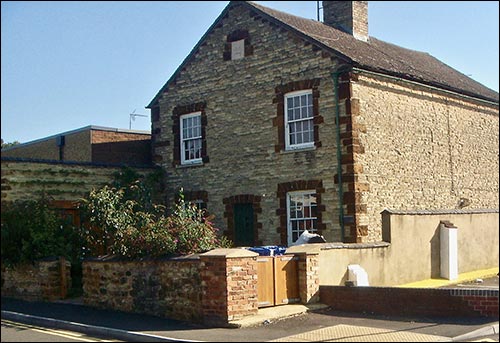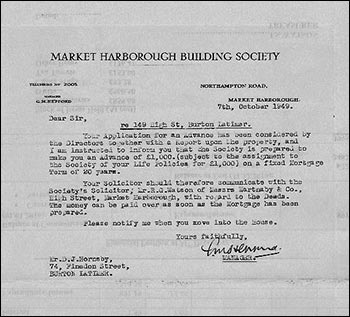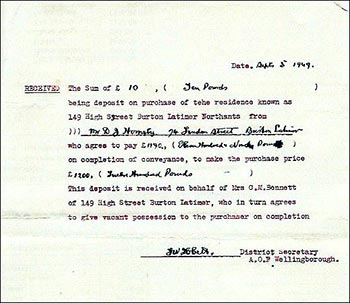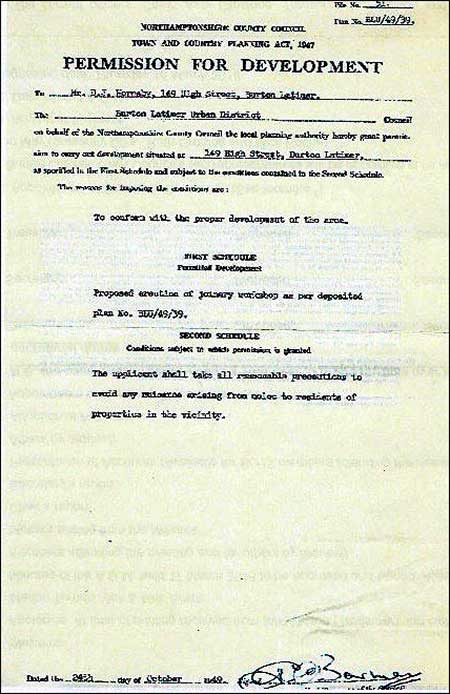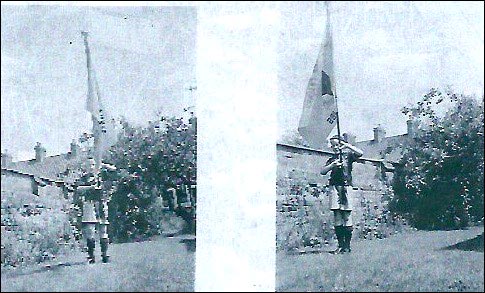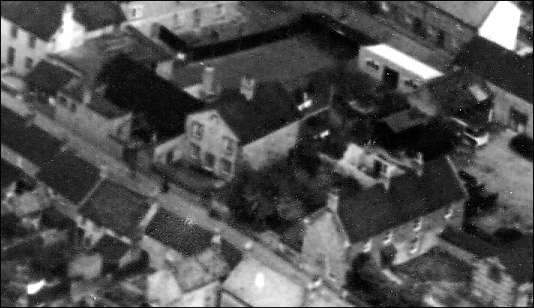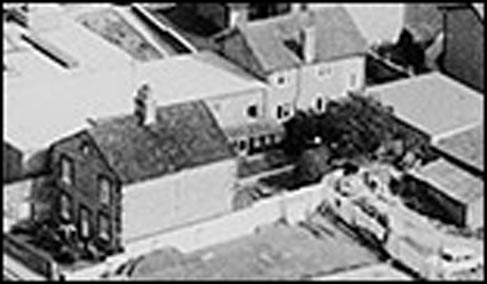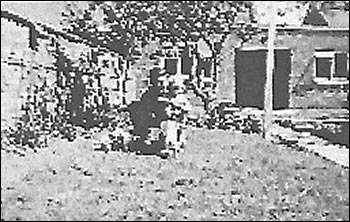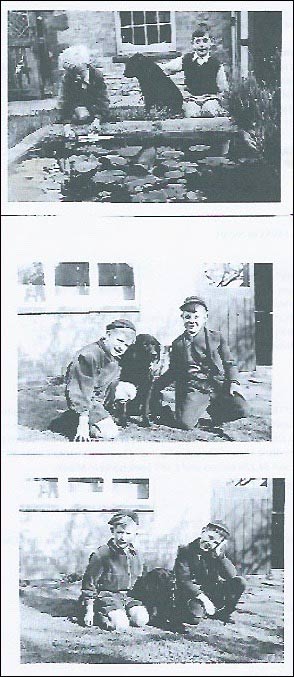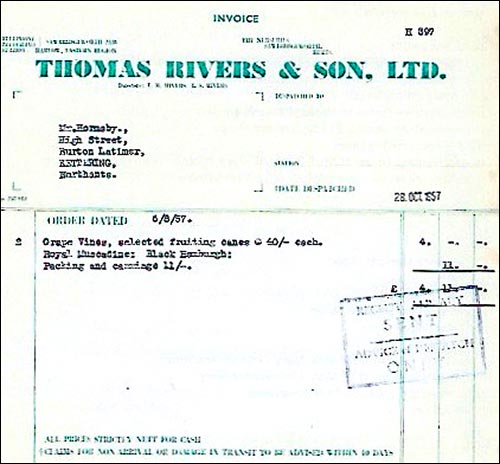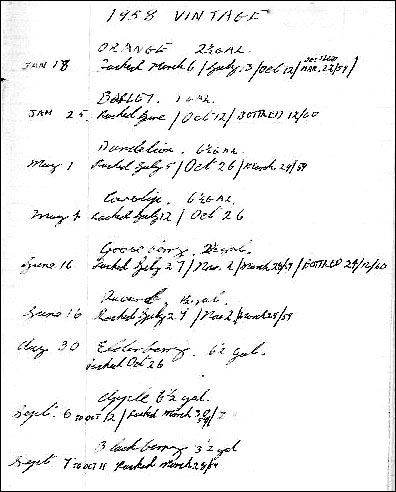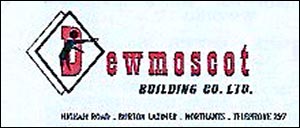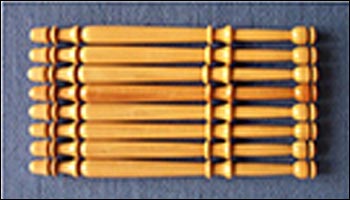Article presented by Margaret Jones (Craddock) from material supplied by Revd William Hornsby |
|||||||||||||||||||||||||||
|
|||||||||||||||||||||||||||
|
|||||||||||||||||||||||||||
Bill was born on 12th February 1949 while his parents, Denis and Mercy were living with Denis' parents, Sydney and Barbara (known as Amy) at 74 Finedon Street. Later in the same year, 149 High Street was acquired by his father, Denis, as shown by the receipts below:
Denis died in 1993 and his wife, Mercy Mildred remained in the home until she passed away in 2009. EARLY DAYS The property was built in 1883 for use as the Wesleyan/Methodist Chapel (see point 24 on the Town Trail). When a new Methodist Chapel was built in Duke Street in 1890 it became a two-home dwelling, and named Chapel House, the resident at the time of the sale in 1949 being Mrs C M Bennett. On taking over the property Denis Hornsby with assistance of his father, Sydney John Hornsby (74 Finedon Street), restored the house and constructed a large workshop in the rear garden. They traded as S J Hornsby and Son. Denis was a Carpenter/Joiner and his father was apprenticed to bricklaying with Tom Swindall of Station Road Rushden in 1921.
The house stands next to the Band Club and young Bill would regularly scale the brick wall to recover lost balls. It was easy to climb the wall from garden to the Club as there was a ledge at about three feet high where the brickwork reduced in thickness. However, returning was more of a scramble – throw the ball back over, take a run and hope the coping bricks weren’t loose as you grabbed them.
The Band Club lawn was very popular on summer’s evenings. Games of ‘Ringers’ or ‘Quoits’ took place – with participants throwing horseshoes to nestle around a metal spike driven into the ground. The sound of metal striking metal, and the cheers of encouragement were punctuated only by the sound of glasses being clinked.
DAILY HAPPENINGS Mercy and her mother (Nanny Swift) had prepared the two lines of washing visible in the photograph (A). Washing was done by hand using water collected into two large, cylindrical, corrugated iron water butts which were used to harvest rainwater run-off from the roof. Most houses at the time had at least one. Rainwater was preferred as it was ‘softer’ and produced less ‘scum’ than the harder tap water. One of Bill’s ‘jobs’ was to use a galvanised iron bucket (no plastic in the early 1950’s) to draw water from the butts and fill the copper in the wash-house. Using two buckets alternately meant that it took less time – but care was necessary to ensure that the bucket filling didn’t overflow thus wasting water. Another ‘job’ was to lay the fire beneath the copper and set it alight. Together with the regular sitting-room fire in the winter and the ‘range’ fire in the kitchen, this was good preparation for when Bill took his Cub’s ‘House Orderly’ badge (awarded to ‘William Hornsby of White Six, 1st Burton Latimer Pack’ on September 25th 1958). Nanny Swift would walk down from her cottage in Isham to help Mercy with the washing. Items would be boiling in the copper and were scrubbed on a wash-board at the London Pattern sink (similar to a Belfast sink – but wider and less deep). Rinsing and wringing out was heavy work. From an early age, Bill learned very early on to ‘be careful of the mangle’. Another job that passed to Bill eventually when he could be relied upon not to feed his fingers between the rollers or into the exposed gears – he gained promotion to ‘handle turning’.
Denis had constructed a goldfish pond at the back of the house and the
In the spring each year the pond would be teeming with newts. Chris and Bill conceived a ‘get-rich-quick scheme’ whereby they would sell newts for a penny a piece. The newts were easily caught by gently allowing your hand to creep beneath the newt as it basked near the edge of the pond. One quick, deft, scoop and you had your prize. They kept the catch in pond water in a galvanized bucket. Having made a few pennies, they left the bucket in the shade, by the back porch. They went up to Smith’s ‘Bottom Shop’ and acquired a few penn’orth of Black Jacks, Fruit Salad and Aniseed Balls. By the time they returned, the great majority of the newts had scaled the side of the galvanised bucket and escaped! They never did ‘get rich quick’. Fencing between 149 and the old farmyard was in a poor state of repair. Many hours were spent playing in the old farmyard area. The limestone rubblework gable ends of the farm outbuilding to the south of 149 are visible in house photograph(A) above. That space was used by Denis and Grandad Sydney for storage of slates (Duchesses, Countesses, Broad Ladies, etc.) quarry tiles and bricks. The dark shape of a rusting corrugated iron roof alongside the boundary of 149 can also be seen. That was used by Denis as a space for storage of timber – and it is believed that the hand-carts were stored here. No motorised transport was apparent in those days – ladders, sand, cement, bricks, . . . everything was carried to site on large-wheeled handcarts pulled with a ‘Tee’ handle. Denis would return home across the yard at the back of Mason’s Garage - his distinctive ‘rising and falling’ gait even more pronounced as he pushed or pulled the handcart. Christopher Underwood, Bill’s friend commented at the time of Denis' death on that distinctive ‘striding’ style of walking - never hurried but resolute. WINE MAKING EXPLOITS By the early 70’s the lawn of the Band Club was covered by an extension to the Club and a house for the steward. Denis built a lean-to greenhouse alongside the boundary wall to assist in growing grape vines which he used to make home-made wine. The document dated 28 October 1957 shown here, indicates the varieties grown, ‘Royal Muscadine’ and ‘Black Hamburgh’.
Denis was a keen maker of home-made wines and Mercy, like many of her generation, was an enthusiastic and diligent ‘bottler’ of summer fruits and a keen jam-maker. Seasonal trips around the local fields and hedgerows were made to collect elder-flowers, elder-berries, crab apples, sloes, damsons, blackberries. All this was supplemented by produce from the garden – apples, black-currants, red-currants, white-currants, gooseberries, . . . ‘Improved’ Kilner jars were sterilised in boiling water as the various fruits were prepared. It was usually one of Bill’s ‘errands’ to ‘Just run up to Mr Wittering’s and get three more packets of rubber rings for the jars. Make sure they’re for the 'Improved’ sort. He knows what I want.” Denis’s wine-making was directed by a number of books including the ‘Encyclopaedia of Home-Made Wines’ by Mary Aylett – Odhams Press Ltd, 1957, 8/6d. A particular speciality was Cowslip Wine. The basic recipe, starting from ‘Boil a gallon of water with three pounds of white sugar . . .” called for ‘ . . .a gallon of the yellow corollas of cowslip flowers . . . “. Obtaining a gallon of cowslip flowers in 2017 would, I am sure contravene every piece of legislation designed to protect our countryside. And, in 2017, it is doubtful if there are very many places where it would be possible to find such a quantity. Sixty years ago it was not a problem. Denis and son, Bill, would simply walk, or cycle down Finedon Station Road to the bridge over the Ise River. At the appropriate season, the meadow on the right-hand side of the road, on the Burton side of the bridge, was yellow as far as the eye could see with cowslips and dandelions. It didn’t take more than a few minutes to harvest a large canvas holdall full of flowers and take them home. Follow the recipe . . . After fermentation has finished ‘ . . . then bung closely and set aside to mature. It can be bottled in three months . . .’. Denis’ wine-making record book shows that on his birthday, 4th May 1958, six and a half gallons of cowslip wine were started! The batch was ‘racked' July 12th and was bottled on October 26th. Six and a half gallons of dandelion wine had been started just three days earlier!
Bottles were stored in a rack in the cupboard in Bill’s bedroom. Sometimes, if the fermentation had not quite been completed, he would be woken by a sound like a shotgun as one of the corks ‘blew’, the cork hit the side of the cupboard, and the glug, glug, glug sound of a bottle emptying was followed by the wonderful aroma of whichever wine had erupted. CHANGE OF WORK
Eventually in about 1967 Denis was looking for a new beginning and returned ‘on the tools’ as a sole trader. His specialism was, of course, carpentry and joinery. He doubled the size of the workshop and reversed the slope of the roof to drain towards the garden into the water butt. He rented a nearby barn at the rear of the property from Frank Underwood, a local builder. The barn was used for storage of materials, as a garage for the van and for making-up items too large for the workshop. Many of the houses in Burton had ‘replacement windows’ – as the old, rattling, draughty, sash windows were replaced by new timber windows made at 149 High Street. Most of these have probably now been replaced. HOUSE WITH TWO HOMES! Growing up in 149 High Street had its own unique attractions – not least that this modest eight-room property had two staircases! The original conversion from a chapel had produced two ‘back to back’ ‘two-up-two-down’ dwellings. Immediately confronting the visitor, entering through the front door was the front stair. To the left was a door leading into a room with a range cooker – the kitchen/living room of the front dwelling. To the right was a parlour room; upstairs were two bedrooms. Entering by the matching back door the visitor encountered the same arrangement, but ‘opposite handed’ so that the kitchens were ‘back to back’. The kitchen/living room was to the right; parlour to the left; stairs in front, two bedrooms above. Downstairs, flooring was quarry tiles laid direct to earth. Each room had a fireplace and a grate. You knew you were ‘really poorly’ if when confined to bed a fire was lit in the bedroom grate! HOUSE RENOVATIONS By the time that the ‘Hornsbys’ were the occupiers, a doorway had been arranged to link the ground floor – underneath the two staircases. The dividing wall upstairs had been knocked through to provide a double-length landing. The consequence of those alterations was that, when visited by relations from London, the youngsters could run in circuits down the side entry, in at the front door; thunder up the uncarpeted front stairs; scoot across the landing; and throw themselves on their back-sides down the carpeted back stairs; out the back door; down the side entry . . . and so on . . . With four or five or six taking part there was always someone pounding heavy-footed up the front stairs and always someone risking life and limb seeking to be fastest back down. The patience of the various parents must have been sorely tried! By the very early 1950s a bathroom had been provided in the back right-hand-side room upstairs as viewed from the back garden and the kitchen was ‘modernised’ with a concrete floor laid with terrazzo tiles. The ‘big project’ was, eventually to remove the front stairs and combine the two front rooms downstairs into a through lounge. The staircase was duly removed; the hole in the first floor was filled in to make an upstairs cupboard; the old lath and plaster ceilings were taken down and replaced by plasterboard and skim. A ‘decorative feature’, very fashionable at the time, was provided by chipping off the plaster to the inside of the northern wall. That revealed the coursed limestone rubble as originally constructed. However, it also revealed the differently coloured infilling of the original side window. Each side wall had, originally two large, pointed arched headed windows. In a raking light it is still possible to see the outlines of the windows on the outside south elevation. About a foot or so from the floor level, were found the rotted out remains of a timber beam (about 3” x 3”) which, it is supposed, might have been to serve as a fixing for pews or benches or panelling. Similar timbers were found at about six feet from floor level – again, possibly associated with panelling? UNEXPECTED DEMOLITION JOB A few years later, in the mid 1960s, it was decided to update the bathroom with a shower and vanity unit. Bill volunteered to take down the ceiling, believing that it would be a similar lath and plaster construction to the sitting-room. He was prepared for it to be a messy and dirty job. So he took tools and overalls into the room, closed the door and started work. The first blow of a hammer and wrecking bar revealed that things would prove very messy. He had not realised that the upstairs ceilings were composed of reed and plaster. Bundles of reeds had been secured to the underside of the ceiling joists by means of laths nailed through two or three inches of reeds into the ceiling joists. An early form of insulated ceiling. The lime and horse-hair plaster was, of course, a good inch or so thick. A hundred and thirty years of accumulated soot, dust and other debris overlay the reeds. The reeds, themselves, had thoroughly dried out and crumbled rapidly to dust. It is not recorded whether the ceilings in the other three upstairs rooms were renewed! If they did Bill had ‘made his excuses’ and fled to spend the morning fishing at Wadenhoe or Felmersham! LACE-MAKING When lace-making took over as an occupation at 149 High Street the rented barn was useful as a space in which to store polystyrene lace pillows. They were initially supplied by Chilham Plastics in Kent and made one at a time from a hand mould. Bill would bring a carload up to Burton about once a week. Later production was moved to Trondex at Northampton when consignments would be delivered direct from the factory in a ‘furniture van’ sized vehicle.
It was in 1975 that Denis John Hornsby, enjoying his hobby of woodturning in retirement, responded to a request from Eunice Arnold (nee Morley), (a lady who was born and grew up in the town before moving to Bedford) for 'some lace bobbins'. The quality of his turned work was widely appreciated and, at a time when people were re-discovering the pleasure of making lace by hand, Denis became a full-time bobbin-maker and supplier of lace-making equipment. Denis' son, Bill, joined the business in 1983, developing his own style of fine woodturning and his Basic Bobbins are turned, sealed and polished in exactly the same way as those of his father’s, and to the same high standard, as his other turned work. Denis’ workshop contained many thousands of bobbin blanks. He knew what he had and where but, unfortunately, he didn’t label the stacks! By 1985 seven members of the family were involved in 'D J Hornsby Lacemaking', (see details on website www.djhornsby.co.uk) travelling the country to attend Lace Days, producing and mailing equipment to more than 57 countries worldwide. The success of the business, however, meant that less time was available for woodturning. Denis' last bobbins were turned a few weeks before his death in 1993 and Mercy welcomed her last customer to the house just three weeks before her death in May 2009. The fourth generation of the family became involved in 2012 when five-year old Joe learned to make lace during his half-term holiday. The firm continues to sell lacemaking equipment all over the world and Bill still enjoys turning bobbins in his spare time |
|||||||||||||||||||||||||||
